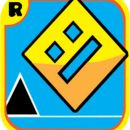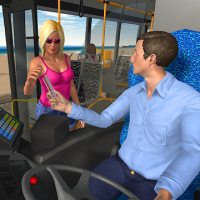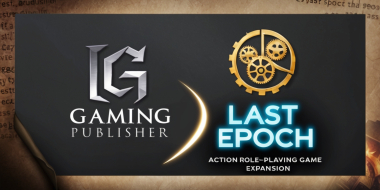Geometry Dash
From the moment I started Geometry Dash, I was drawn into its hypnotic blend of rhythm and challenge. I remember the first time I tapped the screen and watched my square character jump and dodge through an electrifying landscape of obstacles. The immediacy of the control and the audio cues synced to every action left me impressed. It felt as if the entire universe of the game moved in perfect harmony with my every move. I was excited by the promise of endless challenges ahead and the satisfaction of mastering every nuance of each level.
Immersive Gameplay Mechanics
What stands out most for me is how Geometry Dash builds its gameplay around precision and timing. Every jump, slide, and dash is meticulously calibrated to match the pulsating soundtrack. I found myself relying on split-second decisions to navigate spikes, moving platforms, and intricate traps. The gameplay mechanics are simple yet demanding, creating a challenge that always rewards persistence and timing over frustration. Each level forces you to reevaluate your strategy and adapt to new patterns that keep you constantly engaged.
Visual Aesthetics and Design
The visual presentation of Geometry Dash never ceases to amaze me. The game bravely adopts a minimalistic yet vibrant art style that embraces neon colors and geometric shapes. Every level feels like an intricate piece of art where each element is carefully placed to complement the overall rhythm of the scene. In my experience, the design does more than just serve as a backdrop—it actively influences how I perceive and approach each challenge. The crisp, vivid visuals enhance my focus and add a sense of excitement before every jump or descent.
The Impact of Sound and Music
Sound in Geometry Dash is not just an accessory; it is a central pillar of the entire experience. I found that the rhythmic beats and sound effects naturally guide my movements throughout the levels. The music choices stand as unique identifiers for each stage, matching the difficulty and pace of the gameplay. Sometimes, the beat pushes me on, encouraging that extra leap of faith during a difficult segment. In moments when the screen blurs with rapid motion, the sound becomes both a cue and a reward, confirming that I have executed a particularly tricky maneuver with success.
Difficulty and the Learning Curve
One prominent characteristic of Geometry Dash is its steep learning curve. In my early sessions, every attempt felt like a new trial. I learned quickly that precision and knowledge of the level layout are paramount. The game does not hold your hand but rather challenges you to internalize the rhythm and then commit your actions to muscle memory. I vividly remember moments of frustration when mistakes cost me progress, yet each failure was a stepping stone that ultimately built up my confidence. The balance between challenge and self-improvement is one of the core reasons I remain fascinated by the game.
Innovative Level Design
Each level in Geometry Dash is a creative puzzle that feels both fresh and demanding. I explored many stages, and each one introduces distinct obstacles and timing challenges. The levels are crafted with an attention to detail that demands respect. I particularly enjoyed levels where hidden paths or alternative maneuvers would reward a well-timed move. The clever use of platforming elements and sudden shifts in pace helped me understand how subtle changes could completely alter a level’s dynamic. It was as if each new level was a conversation between the game designers and my reflexes.
Endless Replayability
One aspect that I deeply appreciate is the endless replayability offered by Geometry Dash. Despite the initial challenges and repeated attempts, I found myself returning to the game every time I felt like testing a new strategy. The unpredictable nature of each level—where even the smallest misstep can reverse your progress—creates a compelling need to beat personal records. I made it a personal goal to master each level, even if it meant playing the same scene over and over until I perfected my technique. This drive for improvement kept me engaged long after casual play had worn thin.
Exploring Customization and User-Generated Content
One of the most exciting parts of Geometry Dash is its active community and the possibility for user-generated content. I remember spending hours browsing through various custom levels created by fellow players. This endless treasure trove of creativity allowed me to explore experiences that ranged from deceptively simple to overwhelmingly complex. What struck me most was the sheer imagination that other gamers poured into level designs—it was not just a game, but a platform for creative expression. The diversity of levels expanded my understanding of what is possible within the geometry-based realm, and it felt like every custom level was a unique challenge waiting to be unraveled.
Intuitive Level Editor and Creative Freedom
For those who dare to take a step further, Geometry Dash offers a level editor that unlocks a whole new world of innovation. I dived into creating my levels once I had mastered enough challenges on pre-designed stages. The level editor is remarkably intuitive, allowing you to place obstacles, designate timing markers, and overlay your own soundtrack choices. This feature significantly extended my engagement with the game. It provided an outlet for creative expression, turning passive play into an active form of design and storytelling. The empowerment I felt while experimenting with new level designs was incredibly fulfilling.
Social Interaction and the Shared Journey
I found the social aspect of Geometry Dash to be particularly refreshing. Engaging with other players through forums and in-game leaderboards created a sense of community. It was gratifying to receive tips and share accomplishments with fellow enthusiasts. Sometimes, I participated in discussions about the best strategies for navigating especially tricky segments, and these interactions added an additional layer of enjoyment to the overall experience. The game stands as a testament to how shared challenges can foster a vibrant community—even if all you have is a simple square navigating a world filled with vibrant obstacles.
Monetization and Value for Enthusiasts
Geometry Dash is notable for providing a polished and complete experience without an overwhelming emphasis on in-app purchases. Throughout my playthrough, what impressed me was the balance between premium content and free access to core gameplay elements. The occasional in-game purchases are thoughtfully placed so that none of the key challenges or content feels locked away behind a paywall. This structure allowed me to explore every corner of the game without feeling like I was constantly being nudged to spend additional funds. I appreciated how the game respects both the casual gamer and the dedicated enthusiast, elevating the overall value of the experience.
Responsive Controls and Fluid Movement
The controls in Geometry Dash are a marvel in simplicity and precision. I found that the responsiveness of the tap-based input creates a connection between my mind and the game’s reaction. Whether I was aiming for a sudden jump or navigating a rapid series of obstacles, every tap felt like a deliberate action perfectly synchronized with the game’s pace. The fluid movement of the player icon contributes to a gameplay experience that is both engrossing and satisfying. In my sessions, this responsive control scheme often felt as if it was an extension of my own instincts, lending an organic feel to every leap and landing.
Rhythmic Challenges and Timing Mastery
Perhaps the most captivating aspect of Geometry Dash is the intrinsic link between rhythm and gameplay. As someone who appreciates music, I found that the game’s rhythmic challenges pushed me to develop a keen sense of timing. Each beat seemed to signal both the opportunity and danger lying ahead. I often found myself almost dancing to the soundtrack as I navigated an onslaught of obstacles. This ultra-synchronized approach between sound and action not only reinforces my focus but also cultivates a heightened awareness of every shift in the musical score. It was as if success in the game was deeply tied to becoming one with the music's tempo.
Personal Growth Through Repeated Challenges
Over time, I learned that the repeated failures in Geometry Dash were not setbacks but stepping stones toward mastery. Each attempt allowed me to learn a little more about timing, spatial awareness, and the subtle cues embedded in the game. The process of trial and error taught me to analyze each failure, adjust my tactics, and eventually, witness a gratifying sense of progress. I found that the challenge fostered a personal growth akin to learning a musical instrument or a new sport. The perseverance required to overcome each level nurtured both patience and determination, qualities that have extended beyond the digital screen.
Engagement Beyond the Screen
Even after long hours of play, the influence of Geometry Dash extended beyond the screen. I noticed that the rhythm-inspired gameplay and the need for precise timing subtly influenced my daily routine and decision-making. I started to see patterns in music and movement in everyday life, which made me appreciate the game on a whole new level. In certain moments, the game’s challenges reminded me of the importance of timing, perspective, and the beauty of overcoming obstacles. This peripheral engagement helps transform the experience into a multi-sensorial journey rather than a simple pass-time.
Unexpected Discoveries and Hidden Challenges
During my numerous hours with Geometry Dash, I came across hidden details and secret pathways that the community has long celebrated. These aren’t evident at first glance but are gradually revealed to players who dedicate enough time into perfecting a level or exploring a custom map. I often felt rewarded for my attention to detail as these hidden challenges uncovered layers of complexity and charm in the game. The sense of discovery is constant, which keeps the experience rich and ever-evolving. Each hidden element can completely alter the dynamics of a level and transform it into an entirely new challenge.
Interplay of Simplicity and Complexity
What truly fascinates me about Geometry Dash is the striking interplay between its simplicity in concept and the complexity of its execution. At first glance, the idea of controlling a single object through a series of obstacles might appear straightforward. However, as I delved deeper, I found that the game blossoms into a symphony of precise movements, rhythmic cues, and challenging layouts. The layers of complexity enhance my engagement, making it a perpetual puzzle that evolves the more I play it. Every level reveals a new facet of this balance—a delightful dance between basic controls and intricate design.
Experiencing a Universe of Challenges
When I reflect on my journey with Geometry Dash, I am reminded of how the game transformed from a mere digital pastime into an immersive universe full of challenges and personal triumphs. Whether maneuvering through a level that tests your reflexes or diving into community-created maps that push your creative boundaries, the experience remains both unpredictable and endlessly rewarding. The way the game weaves together sleek visuals, intense music, and dynamic gameplay has left a significant mark on my gaming experiences. Every session feels like an adventure, and each challenge is a doorway to learning something new about rhythm, precision, and creative problem-solving.
How to Download and Play Geometry Dash on Different Platforms
Geometry Dash is a popular rhythm-based platformer game available on various platforms. The game offers both free and paid versions depending on the device. Whether you plan to download it on PC, mobile, or use cloud gaming services, here is everything you need to know to get started.
Windows PC: Geometry Dash is available on Windows. You can download it via Steam. Simply visit the official Steam page, purchase (or download the free mobile version if available on certain promotions), and install the game on your computer.
Mac: Geometry Dash is not officially supported on macOS. To play on a Mac, you may need to use an emulator or cloud gaming service.
Chromebook: Geometry Dash is not officially supported on Chromebooks. However, you might be able to play it using cloud gaming services that stream PC games to your device.
Consoles: At this time, Geometry Dash is not available on popular gaming consoles such as PlayStation, Xbox, or Nintendo Switch. Players who wish to enjoy the game on these systems may need to explore cloud gaming options if supported.
Android: Geometry Dash is available on Android devices. You can download and install it directly from the Google Play Store. Ensure your device meets the game’s requirements for a smooth gaming experience.
iOS (iPhone/iPad): Geometry Dash is available for iOS devices. You can download it from the App Store and install it on your iPhone or iPad.
To install Geometry Dash, simply download the game from the official store or platform for your device. After downloading, follow the installation instructions provided by the store to set up the game on your device. For unsupported devices, using an emulator or a cloud gaming service may be a good alternative.
On PC, Geometry Dash requires a basic processor and at least 2 GB RAM. For Android, ensure that your device supports the required OS version and graphical capabilities.
Cheats and Mods for Geometry Dash are available online; however, using cheats or mods may alter your game experience and could lead to potential issues such as loss of progress. It is always recommended to download modifications only from trusted sources.
The unblocked version of Geometry Dash is not officially provided by the developers. Playing the game in school or work environments might require the use of VPNs or cloud gaming platforms, but be aware that these methods can come with restrictions or risks.
Great
Latest Reviews
-
Simulation
FarmVille: Tropic Escape
![]() The idea of escaping to a tropic island is one I would support any day, mainly because of my crazy everyday schedule. However, since that...
Read full review
The idea of escaping to a tropic island is one I would support any day, mainly because of my crazy everyday schedule. However, since that...
Read full review
-
Simulation
Bus Simulator
![]() A lot of bus simulator games promise to give you the real bus driver experience, but they do not deliver on the promise. Before I...
Read full review
A lot of bus simulator games promise to give you the real bus driver experience, but they do not deliver on the promise. Before I...
Read full review
-
Simulation
Flight Simulator
![]() I've always believed that being a pilot is one of the most awesome professions out there. Sadly, the path to becoming a pilot wasn't one...
Read full review
I've always believed that being a pilot is one of the most awesome professions out there. Sadly, the path to becoming a pilot wasn't one...
Read full review
-
Adventure
Gacha World: Create your own team and conquer evil
Gacha World is an Asian role-playing project with anime graphics, MMO component, battles, raids on bosses and knocking out various valuable items from monsters. The... Read full review
Also recommended
-
Action
Grand Theft Auto V
![]() GTA V is an action-adventure game with open world in which you will play on behalf of one of three gangsters. It's possible to plan...
Read full review
GTA V is an action-adventure game with open world in which you will play on behalf of one of three gangsters. It's possible to plan...
Read full review
-
Casual
Candy Crush Saga
![]() Candy Crush Saga, a free mobile game, is a delightful indulgence that exemplifies the "casual" genre within the gaming community. Its easy-to-play nature, coupled with...
Read full review
Candy Crush Saga, a free mobile game, is a delightful indulgence that exemplifies the "casual" genre within the gaming community. Its easy-to-play nature, coupled with...
Read full review
-
Casual
Gacha Nebula
![]() I still remember the moment I first logged into Gacha Nebula. Wandering through an impressive digital cosmos, I was immediately captivated by the dazzling array...
Read full review
I still remember the moment I first logged into Gacha Nebula. Wandering through an impressive digital cosmos, I was immediately captivated by the dazzling array...
Read full review
-
Casual
Candy Crush Soda Saga
![]() Candy Crush Soda Saga is a colourful and exciting match-three puzzle adventure game that has captivated millions of gamers worldwide. Developed by King, it's a...
Read full review
Candy Crush Soda Saga is a colourful and exciting match-three puzzle adventure game that has captivated millions of gamers worldwide. Developed by King, it's a...
Read full review
-
Action
Gorilla Tag
![]() Discovering a Primal Playground
I was instantly captivated when I first strapped on my headset and entered the world of Gorilla Tag. The game invites you...
Read full review
Discovering a Primal Playground
I was instantly captivated when I first strapped on my headset and entered the world of Gorilla Tag. The game invites you...
Read full review
-
Action
Brawl Stars
![]() Brawl Stars is a multiplayer mobile game in which players can play as one of several characters, or as their own avatar. Players can jump...
Read full review
Brawl Stars is a multiplayer mobile game in which players can play as one of several characters, or as their own avatar. Players can jump...
Read full review
Articles
-
![When Football Meets Gardening: A Celebrity Crossover Event in Virtual Realms]() When Football Meets Gardening: A Celebrity Crossover Event in Virtual Realms
When Football Meets Gardening: A Celebrity Crossover Event in Virtual Realms
-
![The Absurd Mission: Saving Humanity from Happiness]() The Absurd Mission: Saving Humanity from Happiness
The Absurd Mission: Saving Humanity from Happiness
-
![Major Publisher Acquires Indie Studio Behind Last Epoch, Paving Way for ARPG Expansion]() Major Publisher Acquires Indie Studio Behind Last Epoch, Paving Way for ARPG Expansion
Major Publisher Acquires Indie Studio Behind Last Epoch, Paving Way for ARPG Expansion
-
![Palworld Evolution: Harnessing Technology for Dynamic Companion Customization]() Palworld Evolution: Harnessing Technology for Dynamic Companion Customization
Palworld Evolution: Harnessing Technology for Dynamic Companion Customization
-
![A Tribute to a Legendary Voice Actor: Celebrating the Enduring Legacy of James "Jimmy Zoppi" Cathcart]() A Tribute to a Legendary Voice Actor: Celebrating the Enduring Legacy of James "Jimmy Zoppi" Cathcart
A Tribute to a Legendary Voice Actor: Celebrating the Enduring Legacy of James "Jimmy Zoppi" Cathcart
-
![Three Titans Set to Clash in the Esports World Cup Rennsport Finale]() Three Titans Set to Clash in the Esports World Cup Rennsport Finale
Three Titans Set to Clash in the Esports World Cup Rennsport Finale

















